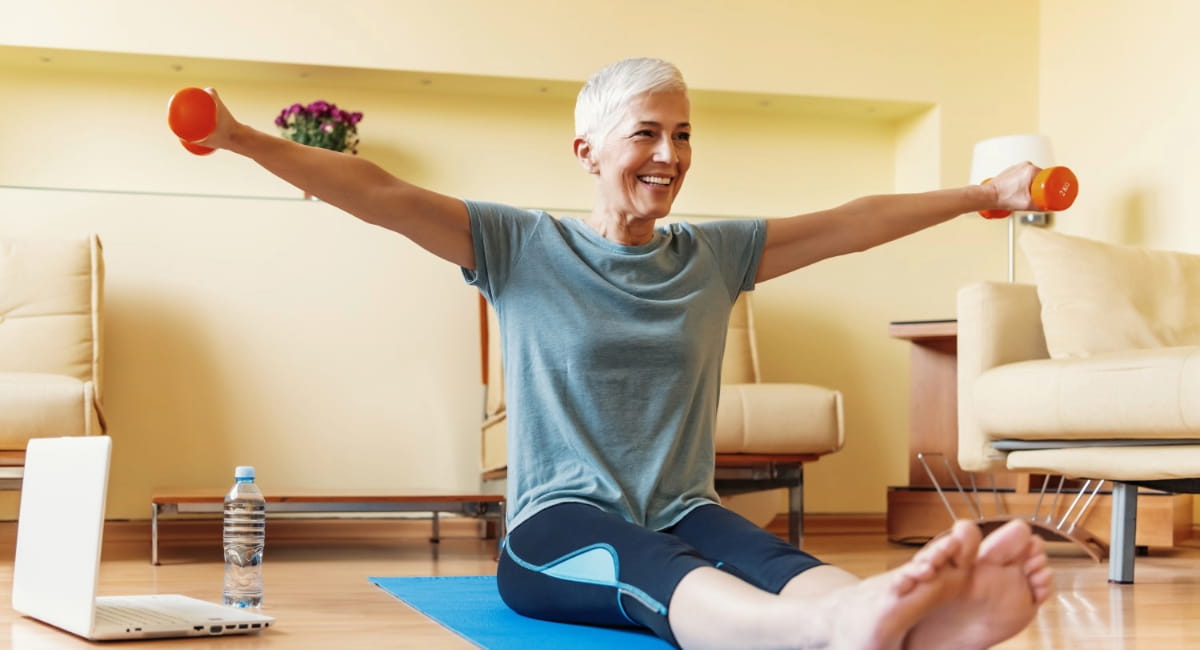"If you can steadily build up your repetitions and sets over time you’ll be much better off. It’s crucial to focus on being able to do the exercises well before you really load up.”—Adam Holdsworth.
Key points
- Some of the benefits of weight training include improved sleep patterns, increasing your metabolic rate, maintaining weight loss.
- It’s important to gradually increase your workload over time, making sure your technique is correct, which will ensure you avoid injuries.
- While older people can be somewhat more at risk of muscular injuries, it’s even more important for their general health and wellbeing that they stay physically active.
Contrary to popular opinion, weight training isn’t just about bulking up and building muscle mass.
There are myriad benefits to this kind of training that can help not only your physical health but your overall wellbeing.
Some of these benefits include improved sleep patterns, increasing your metabolic rate, maintaining weight loss, better posture, improved bone mineral density, and a reduced risk of cardiovascular disease.
A complete fitness program should include some weights training to improve your overall health, as national physical activity guidelines recommend adults include weights-based activities at least two days per week.
To help you get the maximum benefits from weights-based workouts, we sat down with Adam Holdsworth, Health Coach for Remedy Healthcare, to answer some of the most commonly asked questions.

What are some tips for people starting out?
First and foremost, you have to start out slow.
There’s nothing more annoying than making the effort to get more active, only for an injury to set you back.
Adam notes that it’s really important to gradually increase your workload over time, making sure your technique is correct, which will ensure you avoid injuries.
“If you can steadily build up your repetitions and sets over time you’ll be much better off,” he says. “It’s crucial to focus on being able to do the exercises well before you really load up.
“It’s also important that you do the same volume of training for your upper and lower body exercises.”
In other words, don’t skip leg day!
What about setting up a dedicated exercise space at home?
Working out at home isn’t as difficult as you might think.
This is especially true if you’re working from home. You’re more likely to have greater flexibility without a commute, so use that to your benefit. Slip in a quick workout before work and get your day off to a great start!
You don’t necessarily need a lot of expensive and space-eating equipment either.
“As long as you have enough space to do the exercises, that will allow you to reach your goals,” Adam says. “You don’t really need any equipment to get started but it never hurts to get your hands on a cheap set of adjustable dumbbells!”
What can seniors do to maintain their health and wellbeing?
While older people can be somewhat more at risk of muscular injuries, it’s even more important for their general health and wellbeing that they stay physically active.
If you’re older and thinking about incorporating a weight-training routine into your exercise plan, it’s a good idea to consult with an allied health specialist, such as a physiotherapist, exercise physiologist or a qualified and experienced personal trainer.
This way you can get a personalised plan that suits your health and wellbeing situation and needs.
Similarly, Adam recommends a measured start and build-up to your routine.
“For more elderly people, the same principles apply of starting out slow and gradually building up,” he says. “You may require some exercise modification based on starting ability and I would also recommend pairing your strength exercises with some balance exercises to reduce the risk of falls.”
What’s a good workout plan for people starting out?
Always start with a warm-up of light aerobic exercise for five minutes to get your muscles and heart rate moving.
A typical beginner’s resistance-based training program generally has eight to ten exercises that work all the major muscle groups of the body, two to three times per week.
The range of exercises can include things like squats, push-ups, tricep dips, lunges, bicep curls, and planks. Talk to a qualified health and exercise professional to get a personalised workout plan that suits your needs.
You’ll start with one set of each exercise, generally with eight to ten repetitions of each exercise.
Your aim is to gradually increase to two to three sets for each exercise – comprising eight to 12 reps, every second or third day. Once you can comfortably complete 12 reps of an exercise, you should look at progressing further.
It’s also important to consider your body’s rest and recuperation needs as your muscles need time to grow and repair after each session.
Not doing this means not only will you see less progress, but you also run a greater risk of injury. Generally speaking, you’ll need to rest each muscle group at least 48 hours before doing another workout.
Once you’ve built up your fitness and strength, and with the support of an allied health professional, you may want to try adding more repetitions or extra sets to your workout sessions to really increase the intensity.
Disclaimer: Information provided in this article is of a general nature. Australian Unity accepts no responsibility for the accuracy of any of the opinions, advice, representations or information contained in this publication. Readers should rely on their own advice and enquiries in making decisions affecting their own health, wellbeing or interest. Interviewee names and titles were accurate at the time of writing.


